The recent snorkeling tragedy in Hawaii, which made global news, also reignited concerns about snorkeling safety, especially regarding full-face snorkel masks and the potential impact of snorkeling shortly after long flights. Our own experience as journalists and snorkelers, including editor Jeff’s recent challenges with a full-face mask, adds a personal dimension to this ongoing discussion.
Ilya “Billy” Tsaruk and Sophia Kovalevich Tsaruk, a couple from Washington state, tragically drowned while snorkeling off Maui on September 14. They were on a babymoon and expecting their second child. Despite resuscitation attempts, both were pronounced dead at the scene. This tragic event highlights the urgent need for ongoing discussions about snorkeling safety in Hawaii.
While the exact circumstances remain under investigation, this incident is sparking renewed discussions about the potential risks for snorkelers in Hawaii. This issue holds significant implications for potentially hundreds of thousands of Hawaii visitors drawn to our waters for snorkeling each year.
One controversy remains about snorkeling after flying.
An ongoing concern is the “potential” dangers of snorkeling soon after long flights. A state-funded Snorkel Safety Study suggested waiting a few days before entering the water, citing possible connections with drowning incidents and the condition known as Rapid Onset Pulmonary Edema (ROPE), which causes fluid build-up in the lungs. However, the study’s conclusions remain contentious, as seen in discussions with our readers.
Lance P, a medical doctor, emphasized the lack of proof linking flying to snorkeling deaths and suggested that the idea might instead extrapolate from scuba diving issues. Chuck W challenged the recommendation of waiting a week to snorkel, arguing that poor health and inexperience are more significant risk factors.
“My boyfriend almost died off Black Rock Beach from ROPE—per his MD at Maui Memorial Medical Center…Thank God we had our phones in waterproof waist bags.”
BOH reader Karen L.
While not universally accepted as a factor, travelers should remain aware of this potential risk and consider taking precautions.
Full-face masks: convenience or hazard?
While full-face snorkel masks are popular for their ease of use, they have raised safety concerns. Unlike traditional masks, they’re harder to clear when water enters and may pose a risk of CO2 build-up, leading to dizziness or difficulty breathing.
Jeff, one of our editors, experienced some distress when he recently wore a full-face mask for the first time. Despite his snorkeling expertise, it filled with water while he was in the ocean. He also reported it was significantly more challenging to clear water in the mask than expelling it from a standard snorkel.
BOH reader Fran previously mentioned feeling claustrophobic while using a full-face mask and felt that traditional masks allowed better air intake. Susana K said that it seems more recent drownings have been associated with full-face masks, suggesting that they might be less safe than separate mask and snorkel setups.
“I’ve been reading bits & pieces that there may be a connection between snorkel drowning & low O2 from the masks…I think there needs to be real studies on this.”
BOH reader Judy G.
Properly fitting and reputable brands can mitigate risks, but caution is advised.
The role of tour operators and preparation.
During a boat-based snorkeling excursion, Jeff faced inadequate preparation when his mask wasn’t tested in shallow water, leading to complications. We know this all too well, and we still have issues. This highlights the importance of tour operators providing comprehensive guidance and safety checks. Visitors should always test their equipment in a controlled environment and confirm safety protocols before venturing out. It’s especially crucial when snorkeling alone, as immediate help may be unavailable in an emergency.
Hawaii snorkeling safety: understanding the risks.
Drowning remains one of the leading causes of death among visitors to Hawaii, with tourists accounting for 90% of snorkeling-related incidents. This disparity is often due to unfamiliarity and lack of preparedness to deal with Hawaii’s ocean conditions, equipment challenges, and pre-existing health issues. The study also found that low blood oxygen levels, often linked to Rapid Onset Pulmonary Edema (ROPE), might play a significant role, even affecting experienced snorkelers.”
“Recommending a policy of waiting a week to snorkel upon arrival to Hawaii is ridiculous… many people do not know the limitations.”
BOH reader Chuck W.
Safer snorkeling in Hawaii.
For a safer snorkeling experience, consider these tips:
- Test your equipment in shallow water to ensure a proper fit and comfort.
- Wait a few days post-flight to acclimate before snorkeling.
- Always snorkel with a buddy and maintain visual contact.
- Choose lifeguarded beaches and avoid rough waters.
- Consult a doctor about any health concerns before snorkeling.
- Opt for simpler snorkels without modifications that may restrict airflow.
- This version retains all key points while improving clarity and flow.
The need for further snorkeling safety research.
While the Snorkel Safety Study has highlighted certain risks, feedback from Beat of Hawaii readers and others underscores the need for more comprehensive research. Understanding the correlations between flying, snorkeling, and drownings is crucial to improving safety and preventing future incidents.
Snorkeling safety in Hawaii requires awareness beyond equipment choice. By considering factors like post-flight risks, proper equipment use, familiarity, and preparedness for Hawaii ocean conditions, visitors can take proactive steps to ensure a safer Hawaii vacation. For further insights on snorkeling safety, explore our prior coverage of Hawaii visitor drownings.
We welcome your input!
Photo Credit: Jeff, Beat of Hawaii editor, using a full face mask for the first time.
Get Breaking Hawaii Travel News
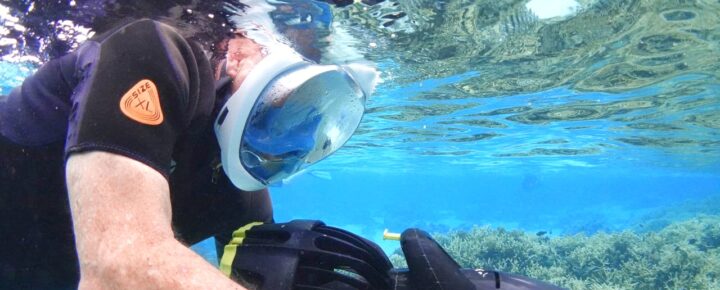
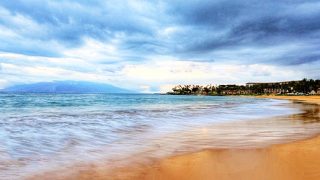
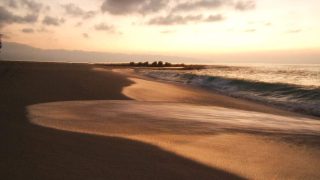
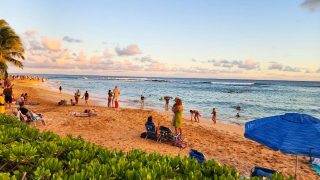
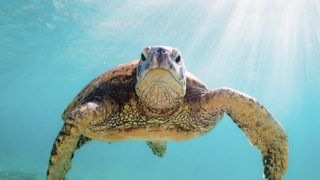
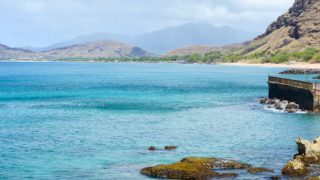
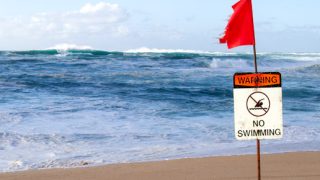
I snorkel with a conventional mask directly after getting off airplane most every time we go.
It would be a good idea to try to snorkel in a pool for the first time. Tread water and be able to adjust mask, blow out water, roll over and back.
My wife gets claustrophobic with mask and water mix. Not good if happens in water over your head. After trying noodles and boggie boards we started bringing a life jacket for hands free snorkeling. She leaves flippers at home also. I pull her around like a tug boat. Then she can be assured I am right there and can enjoy watching the fish. Should be able to rent a life jacket from Kyack rental.
We go to the Big Island, I don’t think we ever go out 150 ft. I see the fish by the rocks which is near the shore.
If 10 people are snorkeling your chance of shark encounter is max 10%. Other people around also means help in time of need.
Be careful out there.
Snorkeling can be disorienting even for myself a Red Cross certified life guard and Water Safety Instructor. I suggest the use of a boogieboard with leash or a kickboard for a resting support to enable one to rest and normalize their breathing occasionally.
Among some of us who really enjoy snorkeling and diving the full face masks have gained a reputation as “death” masks. They have more volume to clear, so there is going to be more re-breathed CO2 with each breath. That little tube is the snorkeler’s lifeline, so care needs to be taken when selecting and using snorkels.
I don’t think the time relative to landing is a significant factor. On one trip back-in-the-day I drove from HNL directly to Hanauma Bay and went snorkeling. I was fine.
Lastly, I looked up info about the reported deaths. I have snorkeled at that location multiple times, and consider it a beginner spot. That makes this more tragic, IMO, because no one should have died there.
The young couple died in Maui, not Oahu.
None of the news articles I have read about the couple who died mentioned they had full face masks. Many commenters are assuming they did, but that isn’t necessarily the case.
There are many problems with full face mask snorkels. Sanitation is difficult. It’s easy for someone to panic and not have the presence of mind to remove the mask. Instead they swallow water and drown. All masks leak, but a leak in a mask + separate snorkel is much easier to manage than a leak in a full face mask. It’s not good technology and I think that operators that advocate/rent these out should think about risks to their client and the risk of lawsuits against their business. Beware.
Although tragic, the death of the people on their Baby moon is not the fault of Hawaii nor the snorkel rental companies. I also live in a tourist destination, albeit mountainous with glacier filled lakes. It is heartbreaking each year, when people who are on vacation, make poor choices which they would not make if they were at home, and they die. Perhaps it is the fault of the Instagram influencers who share how magical their vacation seems to be. (You do know that these folks make multiple recordings until they achieve the ‘perfect’ one to post? Sometimes with a crew?) Perhaps it is the sense of urgency and scarcity as someone only has one vacation a year, they are spending more than normally budgeted, and they want to live their dream.(Over spending and feeling pressure to have it all) The attitude of ‘if they can do it, so can I’. (How many takes did it take to create the reel? Were they certified and with experience?)
Please, do not try to win Darwin award prizes in Hawaii.
Wow.
Darwin Award, Really???
You win the Vicious Award for the most callous post I have ever read on Beat of Hawaii.
You know a 25 and 26 year-old with a baby due in December all died leaving an orphan two-year old boy.
Wow, just Wow.
aloha from Maui…so tragic & hoping for more facts…any reputable company such as The Snorkel Store in Ka’anapali does not and never will provide rentals for full-face masks- they say they are not safe and they would never put their customers in jeopardy. I have seen entire families with these contraptions on their faces & my observance is they do not look like you can breathe freely in them unless you want to breath your own air (look at face masks studies from Pandemic that showed horrible outcomes..e.g. the worldwide Cochrane Study)..not only that, but their faces are covered with sunscreen goop which clearly could run into their eyes & cause panic if they can’t get that darn thing off!
Flotation, Flotation , Flotation.
Just take a small inexpensive body board and you will always have your own “lifeguard ” attached to you.
Who cares if you look goofy, you will be alive!
I’ve been following the info on full face masks for years. What drew my attention was I thought this was something I would enjoy using. It didn’t take long to discover the problems with these masks, as noted with the link one of your readers posted. I believe most tourists rent their gear. I believe a good first step would be to not have these masks available for rental. Along with the CO2 issue, I’ve witnessed many people struggling to get the masks off their faces. Yes, they look cool, but if there’s any chance they are one of the cheaper models the risks add up even more.
I may have looked silly, but using the pool at the Kaanapali Beach Hotel (the whale shaped one that’s more of a kiddie pool than anything else) to work out the fit of my snorkel and (prescription) mask, as well as work out the best way to arrange a GoPro on the mask, was time very well spent. When I went out to Black Rock and on a Trilogy snorkel cruise, my gear was ready to use and I was confident in its function.
37 trips to Hawaii and with the exception of the very first one, I was in the ocean snorkeling the day after my arrival and on some days it was actually on the day of arrival and have had No issues whatsoever. But then I have my own snorkeling gear with prescription lenses and I am wise enough to know, as Dirty Harry would say, what this man’s limitations are. It would appear that once again you are pushing an agenda that is telling people what they shouldn’t do on their vacation to Hawaii. Not exactly a welcoming post or voice by the BOH.
Hi Don~ did not get the imperssion anyone is pushing an agenda. The editors are laying out a scenario and letting you make your own decision. Good for you that you can snorkel immediatly, that does not necessarily apply to the remaining 8 billion other humans on this planet. Cheers
Please…..this was an article about a young couple who died and you want to talk about an “agenda”, Don? This is about safety recommendations to avoid another tragedy. Be grateful that nothing happened to you, but it’s not a guarantee…
Safety recommendations based on facts, of which there are very few about the use of those masks and there is just as much lack of data about not snorkeling unless you wait days after arriving on the Islands. Life is full of choices and they made their own which sadly cost them their lives as well as the baby she was carrying while leaving another child now parentless, too. When facts are available, post them! Otherwise, we don’t need to be lectured to about unproven possibilities.
Agenda? Asking people to maje informed decisions about their activities and pointing to information hardly seems an agenda to tell people how to live their lives. Your experience could be totally irrelevant to another person, not knowing all the potential risk factors. BOH is helping make travel safer by giving information and pointing our places to do more research. It always amazes me how little so e travelers know about their destination or activities. Tbe person you see in the mirror is most responsible for your safety, but too many of us don’t know, what we don’t know.
As a scuba diver I am aware of the issues clearing water from them.
Upon researching full face makes, I believe there is a legitimate concern for CO2 buildup over time. Per the national library of medicine (DOI: 10.1055/s-2003-39084), “A snorkel adds an additional dead space of 160-170 ml and causes an increase in the concentration of CO2 in the inspired gas due to expired air trapped in the snorkel which is then re-inspired.” With a tube style snorkel between 33% and 41% of the air you breath in has already been exhaled by you. Now if you factor in a full-face mask, the volume of the air chamber is much larger than that of the snorkel tube. So, the concentration of CO2 increases in this space over time, as you’re exhaling just a portion of that volume with each breath. They really are not safe, I’m not sure if really good, high-end ones are safer, but why risk it… It’s not worth dying over!
I agree with Chuck W that poor health and inexperience are significant risk factors. The recommendation to wait a week after flying doesn’t make sense, especially since some visitors only come for a week. Instead, they should start it slow …. Alcohol and/or medication might also be a factor … I would like to find out how the young (and seemingly healthy) couple died? Were there waves, rocks, a shark? My guess is something triggered this and they panicked & a full face snorkel mask it too difficult to take off. Tragic!
Okay, so the visitor has one week for his HI vacation, but the authorities are saying, ‘Oh, by the way, if you are planning on going snorkeling, you best not do so for at least 4-5 days, for you safety. ‘. That’s going to go over huge! Yes, a whole lot more effort to verify the cause of this trauma is needed. Maybe the is some commonality with the victims? The all had fish on the plane coming over?!
I hope the details of the investigation into the snorkel deaths of this couple are made public. Those of us who snorkel want to know what the circumstances that led to the deaths were…and how best we can avoid them. This was a young couple, presumably healthy. It is worrisome. It was reported they were found 100 or 150 feet offshore, in calm waters. That they Both suffered a ROPE death seems completely unlikely.
This NIH article sheds some light on this issue. I Would Never Wear A Full Faced Snorkel Mask.
ncbi.nlm.nih.gov/pmc/articles/PMC10735670/
We’ve been using full face masks for several years without issue.
I have a moustache that causes issues with the seal of traditional masks. We got the original European version as they weren’t available in the US yet. Had them shipped from Germany.
These are very well designed and fit well. The snorkel is bifurcated into separate intake and exhaust paths that are controlled by a series of one way valves. Water automatically cleared through a purge valve in the mask.
My son rented a knockoff version and it fogged immediately and it was generally useless. I’d be wary of the knockoffs.
With all that said, I think much of the discussion around dangers of full face masks is just speculation and conjecture because they’re different. People die using conventional snorkeling regularly and I haven’t seen any study that shows a statistical correlation indicating full face masks are any more or less dangerous than conventional gear.
I snorkel on a regular basis around the island and have tried the full face mask. I had difficulty breathing and an even harder time trying to dive under water. In my opinion, full face masks are very dangerous for anyone and should be banned. Invest in a high quality traditional mask and snorkel. You can use baby shampoo as an anti-fogger. And in a pinch, rubbing leaves from beach Naupaka will work, too. Happy snorkeling!
Very easy to overexert yourself in watersports if you haven’t maintained some physical conditioning – especially in the repetitive movements involved . Many sedentary people launch right into vigorous physical activity when on vacation without preparing for it prior to departing. I see it all the time when I’m home. People in poor physical condition trying to undertake strenuous activities such as jogging, hiking, and watersports and finding out that it’s too much for their physical condition. The trail leading to Manoa Falls in particular comes to mind…
Best Regards
All good general tips. Would be helpful to know more details to provide context. Such a sad loss. I really, really hope there are extenuating circumstances to explain why this happened because not only did they die, so di their unborn child and perhaps most tragically they left behind a toddler
There’s been a lot of discussion around full face masks and knock offs that have made their way to eBay and even some Amazon dealers, versus the official full face masks that give proper exhaust out of the mechanism. So the question needs to be asked if these were legitimate or knockoffs?
For many visitors to Hawaii; it is their first time in the ocean. A mask and snorkel aren’t easy to adjust to. I recommend simple swim goggles and fins
I agree. You can just swim at leisure and put your swim goggles on to see the beautiful colored fish or even swim with the turtles …at least that’s what I do. I just don’t like to have plastic or rubber in my mouth…
I used to use a full-face mask but quit using it after reading about the potential CO2 buildup. I was snorkeling with a group in the Galapagos islands and saw an older man struggling with his full-face mask while in the ocean. I went over to check on him and helped him remove his mask. He was pale as a ghost. Thankfully there was a panga from our ship nearby and we flagged it down and got him on board and he was OK.